By George Tsai
The letter writer says all the Chinese storefront signs are displayed without English, making him feel like he lives in an incongruous community. Gino Fazio said in the letter: “I never in my entire life felt like I didn't belong in a community due to ethnic diversity. I have to say that for the past several months our neighborhood on Northern Boulevard in Little Neck is starting to feel like downtown Flushing. The fabric of my community is starting to changeÉ''The statement apparently smacks of his deep frustration over the unexpected change in the community's ambience. And I can visualize what he portrayed in his letter.Since I have never been to that area, I cannot tell if all the storefront signs are written 100 percent in Chinese as Mr. Fazio claims. But conventional wisdom tells me that's unlikely. How could those merchants have been so foolish as to turn their back on prospective customers of other ethnicities? Last year another reader and a local politician made the same claim about downtown Flushing. Their assertion proved inaccurate. In fact, 95 percent of the storefront signs carry English in smaller letters, as a vast majority of their customers are Chinese and Koreans.While saluting him for his patriotism manifested in his letter, I have serious reservations about his ability to discern the origin of those stores. He probably has taken all Asians for Chinese. In the meantime, Mr. Fazio takes City Councilman John Liu (D-Flushing) to task for “heading in the wrong direction.'' That may mean Liu failed to encourage the new immigrants to learn English while offering free Chinese classes for English-speaking people.As a naturalized American, I know how he feels about the atypical scene and how the new immigrants feel about his perception of them.However, it's fairly normal for the Chinese immigrants to speak their native language or dialects in their community. Go to the Polish and Greek communities in Chicago, or the Arab community in Detroit, or the Vietnamese in Houston or the Jewish in Brooklyn, and you will hear them speak their mother tongue, not to mention the Hispanics. Bear in mind that ours is a nation of immigrants. It may take a generation to change that mode of life. Be patient!Like Mr. Fazio, I have more than once called upon these new immigrants to do the same if they want to enjoy the mainstream life of America. But there is a problem. A vast majority of them came here when they were in their mid-20s, 30s and 40s. When people reach those age brackets, they will find it very hard to pick up a foreign language and change their customs and habits.Language barrier and cultural differences are apparently the stumbling block to their assimilation into the community. Don't worry. Their children can certainly make a smooth transition, just like Mr. Fazio, who was probably born in this country 43 years ago. Believe it or not, this year 81 out of the 300 semi-finalists for the annual Intel Science awards are children of Chinese immigrants.As you know, the goal of the new arrivals is to seek a better life, but most of them don't have special skills we need. So they have to work their fingers to the bone for a measly pittance of a wage, yet they have to send as much money as they possibly can to the loved ones they left behind. Some even have to pay huge amount to smugglers known as snakeheads. Therefore, they can spare little time to learn English.Some struggle to realize their American dream, while others doing odd jobs perhaps have no intention of staying here permanently. To some, the “paradise'' is but an illusion. They never thought several strangers, men and women, would share a small apartment with one toilet.Also, I disagree with Mr. Fazio's point of view regarding the free Chinese classes for the English-speaking people. There is nothing wrong about that.As I understand it, Chinese study is more popular than ever in the United States. President Bush has signed into law a bill appropriating $1.6 billion to create programs for the study of five foreign languages, including Chinese. Besides, 17 percent of American high schools intend to add Chinese study to their curricula. Many young people are on the waiting list to attend Chinese classes in Oregon schools.Ironic as it sounds, China, still a developing country, has emerged as the third largest economy in the world, after the United States and Japan. And it could surpass Japan in the foreseeable future. Moreover, its foreign exchange reserve has exceeded $1 trillion, the largest in the world now, according to various sources.

































